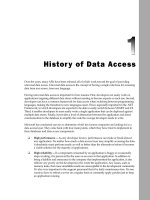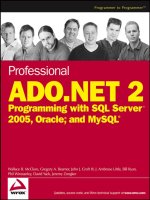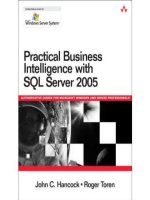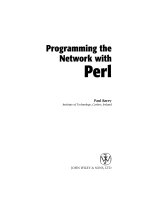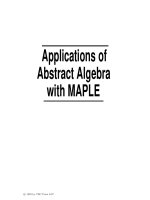- Trang chủ >>
- Khoa Học Tự Nhiên >>
- Vật lý
wang - physics with maple (wiley, 2005)
Bạn đang xem bản rút gọn của tài liệu. Xem và tải ngay bản đầy đủ của tài liệu tại đây (6.39 MB, 610 trang )
Physics with Maple™
The Computer Algebra Resource for Mathematical Methods
in Physics
Frank Y. Wang
WILEY-VCH Verlag GmbH & Co. KGaA
December 11, 2005
Contents
Preface XI
Guide for Users XVII
Bibliography XIX
1 Introduction 1
1.1 Overview 1
1.2 BasicAlgebraandSolvingEquations 10
1.3 Calculus 14
1.4 DifferentialEquations 17
1.4.1 ExactSolutions 18
1.4.2 SpecialFunctions 19
1.4.3 NumericalSolutions 21
1.5 VectorsandMatrices 24
1.6 Summary 36
2 Oscillatory Motion 41
2.1 Simple Harmonic Oscillator . . . . 41
2.2 Damped Oscillation . . 45
2.2.1 Overdamping 46
2.2.2 Underdamping 48
2.2.3 CriticalDamping 49
2.3 Sinusoidally Driven Oscillation . . . 50
2.4 PhaseSpace 60
3 Calculus of Variations 71
3.1 Euler–LagrangeEquation 71
3.2 MathematicalExamples 72
3.3 SymmetryProperties 80
3.4 PrincipleofLeastAction 82
3.5 SystemswithManyDegreesofFreedom 86
3.6 ForceofConstraint 89
Physics with Maple™: The Computer Algebra Resource for Mathematical Methods in Physics. Frank Y. Wang
Copyright © 2006 WILEY-VCH Verlag GmbH & Co. KGaA, Weinheim
ISBN: 3-527-40640-9
VI Contents
4 Integration of Equations of Motion 101
4.1 LinearizationofEquations 101
4.2 Double Pendulum . . . . 102
4.3 Central-forceProblem 108
4.3.1 KeplerProblem 109
4.3.2 CorrectionTerms 117
4.4 MotionofaSymmetricTop 118
4.5 Nonlinear Oscillation and Chaos 126
4.6 SummaryofLagrangianMechanics 134
5 Orthogonal Functions and Expansions 139
5.1 FourierSeries 139
5.2 FourierIntegrals 143
5.3 Orthogonal Functions in Complete Sets 146
5.4 Legendre Polynomials . 147
5.4.1 GeneratingFunctionandRodriguesFormula 151
5.5 BesselFunctions 152
5.6 SummaryofSpecialFunctions 163
6 Electrostatics 169
6.1 Coulomb’sLaw 169
6.2 Curvilinear Coordinates . 172
6.2.1 SphericalCoordinates 174
6.2.2 CylindricalCoordinates 178
6.3 DifferentialVectorCalculus 180
6.4 ElectricPotential 181
6.4.1 Cavendish’sApparatusfortheInverseSquareLaw 186
6.4.2 MultipoleExpansion 190
6.5 ElectricFieldandEquipotential 197
7 Boundary-value Problems 205
7.1 TheoryofPotential 205
7.2 MethodofImages 206
7.3 Complex-variableTechniques 208
7.4 LaplaceEquationinCartesianCoordinates 214
7.5 LaplaceEquationinSphericalCoordinates 218
7.6 LaplaceEquationinCylindricalCoordinates 223
7.7 Summary 231
8 Magnetostatics 235
8.1 MagneticForces 235
8.2 Biot–SavartLaw 238
8.3 VectorPotential 244
8.4 ForceandTorqueonMagneticDipoles 250
8.5 SummaryofElectromagnetisminStaticConditions 253
Contents VII
9 Electric Circuits 259
9.1 ResistorsinSeriesandinParallel 259
9.2 Kirchhoff’s Rules . . . 261
9.3 Direct-currentCircuits 263
9.3.1 RC Circuit 264
9.3.2 RL Circuit 265
9.3.3 RLC Circuit 266
9.3.4 LissajousFigures 269
9.4 Alternating-currentCircuits 271
9.4.1 Impedance 271
9.4.2 Bridges 277
10 Waves 283
10.1WaveEquation 283
10.2VibratingString 287
10.3SinusoidalWavesinLinearCombinations 290
10.3.1 ComplexNotation 290
10.3.2 FourierIntegrals 291
10.3.3 UncertaintyPrinciple 292
10.4GaussianWavePacket 297
10.5Two-dimensionalCircularMembrane 301
10.6ElectromagneticWaves 305
10.6.1 Electric-dipoleRadiation 306
10.6.2 SynchrotronRadiation 312
11 Physical Optics 321
11.1LightasanElectromagneticWave 321
11.1.1 Polarization 322
11.2MathematicsofInterference 325
11.3Interference 328
11.3.1 Double-slit Interference . . 329
11.3.2 Multiple-slit Interference . . 330
11.4Diffraction 334
11.4.1 Resolution of Single Slits and Circular Apertures . . . . 336
11.5DiffractionGrating 340
11.6FourierTransformSpectrometry 343
11.7FresnelDiffraction 346
12 Special Relativity 353
12.1LorentzTransformation 353
12.1.1 LengthContractionandTimeDilation 357
12.1.2 Addition of Velocity . . . . 361
12.1.3 Doppler Shift . 363
12.2RelativisticKinematicsandDynamics 367
12.3TransformationsofElectromagneticFields 373
VIII Contents
13 Quantum Phenomena 379
13.1 Blackbody Radiation . . 379
13.2PhotoelectricandComptonEffects 383
13.3 Wave–Particle Duality . 385
13.4BohrModeloftheHydrogenAtom 387
13.5DielectricsandParamagnetism 390
14 Schrödinger Equation in One Dimension (I): Unbound States 401
14.1FormulationofQuantumMechanics 401
14.2ZeroPotentialandPlaneWaves 403
14.3StepPotential 404
14.3.1 Step Potential (E>V
0
) 404
14.3.2 Step Potential (E<V
0
) 407
14.4BarrierPotential 408
14.4.1 Barrier Potential (E>V
0
) 409
14.4.2 Barrier Potential (E<V
0
) 410
14.5SummaryofStationaryStates 411
14.6WavePacket 414
14.6.1 ReflectionofWavePacket 417
15 Schrödinger Equation in One Dimension (II): Bound States 425
15.1DiscreteSpectrum 425
15.2InfinitePotentialWell 426
15.3FinitePotentialWell 428
15.4SeriesSolutionandHermiteEquation 436
15.5 Linear Harmonic Oscillator . . . 438
15.6HomogeneousField 441
15.7MorsePotential 445
15.8 Bound Nonstationary States . . 449
15.9Two-stateSystem 450
16 Schrödinger Equation in Three Dimensions 465
16.1Central-forceProblem 465
16.2SphericalHarmonics 466
16.3 Angular Momentum . . . 470
16.4CoulombPotential 472
16.5HydrogenAtom 474
16.5.1 ElectricPotentialDuetotheElectron 492
16.5.2 HybridBondOrbitals 494
16.6InfiniteSphericalWell 497
17 Quantum Statistics 509
17.1StatisticalDistributions 509
17.2Maxwell–BoltzmannStatistics 512
Contents IX
17.3IdealBoseGas 515
17.3.1 LowDensityandVirialExpansion 518
17.3.2 Bose–Einstein Condensation at Low Temperature . . . . 522
17.4IdealFermiGas 528
17.4.1 LowDensityandVirialExpansion 530
17.4.2 SpecificHeatofaMetalatLowTemperature 531
17.5RelativisticGases 538
18 General Relativity 545
18.1BasicFormulation 545
18.2NewtonianLimit 549
18.2.1 GravitationalRedshift 551
18.3SchwarzschildSolution 553
18.4 Robertson–Walker Metric . . . . . . 563
18.4.1 EvolutionoftheUniverse 565
Appendix
A Physical and Astrophysical Constants 577
B Mathematical Notes 579
B.1 LegendreEquationandSeriesSolutions 579
B.2 Whittaker Function and Hypergeometric Series . . 583
B.2.1 Harmonic Oscillator . . . . 584
B.2.2 MorsePotential 586
B.2.3 CoulombPotential 587
B.3 Clausius–MossottiEquation 589
B.4 Bose–EinsteinIntegralFunction 592
B.5 EmbeddingFormula 596
Index 599
Preface
Physics is guided by simple principles, but for many topics the physics tends to be obscured in
the profusion of mathematics. As interactive software for computer algebra, Maple
†
can assist
educators and students to overcome the obstacle of mathematical difficulties. The objective
of this book is to introduce Maple both for teaching and learning physics by taking advantage
of the mathematical power of symbolic computation, so that one can concentrate on applying
the principles of setting equations, instead of technical details of solving equations.
Most physics textbooks were writtenbefore advanced computer software became conveniently
available. The conventional approach to a topic places emphasis on theory and formalism, de-
voting many paragraphs to performing algebraic operations in deriving equations manually;
other than some well known examples, most applications of theory are omitted. One reason
that those examples are well known is that they admit analytic solution: they typically rep-
resent simplified situations that generally fail to fully reflect the reality. In most situations,
analytic solutions simply do not exist, and one cannot proceed without the assistance of a
computer. Although some books have sections discussing numerical methods, many of them
contain just the theory of numerical methods, and one is required to possess programming
skill for practice; this part is hence generally neglected. Essentially all experiments in physics
measure numbers, so any formulation must eventually be reducible to numbers. Under a con-
ventional curriculum, a student’s ability to calculate and to extract numerical results from
the formalism is somehow inadequate. The result is not surprising: a student may be weak
in those areas, and he or she thus achieves only partial comprehension because of technical
difficulties.
Maple can remedy some deficiency or weakness in traditional training. Using Maple, one
can manipulate equations and diminish tedious paper work that distracts from the main focus
of learning physics. It is particularly useful in problems that require extensive calculations,
such as problems in calculus involving the chain rule, change of variables, and integration
by parts. Maple is such a powerful software that an educator can introduce more advanced
topics without being restricted to the presumed mathematical background of students, and a
student can explore more advanced applications without fear of mathematical difficulty. From
an analytic solution one can obtain numerical results by substituting numerical values. For
equations that admit no analytic solution, one can, in practice, solve them numerically if
proper initial conditions are supplied. An important feature of Maple is that it can produce
†
Maple is a registered trademark of Maplesoft, a division of Waterloo Maple Inc.;
see
.
Physics with Maple™: The Computer Algebra Resource for Mathematical Methods in Physics. Frank Y. Wang
Copyright © 2006 WILEY-VCH Verlag GmbH & Co. KGaA, Weinheim
ISBN: 3-527-40640-9
XII Preface
instant graphics to serve as a visual guide, which is generally the best way to understand the
underlying physics.
Take the Bessel functions as an example: many students and even researchers find these so-
called special functions alien, despite their frequent recurrence in diverse branches of physics.
One reason is that the treatment of Bessel functions requires numerical methods, with which
not everybody is adequately familiar. Many physicists have never produced a number from
such functions, and a worked example of expansion in Bessel functions is lacking from most
commonly used textbooks. Can we imagine a student learning the relations for the trigono-
metric functions and Fourier series without ever producing a number? Maple reduces routines
of the Bessel functions to a simple command, which spares one from a tedious and protracted
process of programming and debugging, and can produce plots interactively. The most effec-
tive way to learn such functions is to practise them, by calculating the expansion coefficients,
similar to those in the Fourier series, and observing the graphical output. Maple can serve not
only for pedagogical purposes: in practice it is much more convenient to evaluate coefficients
for expansions in orthogonal functions with a computer than it is by long manual calculations.
There already exist many books on Maple, which indicates that Maple is a common but intrin-
sically complicated software. Maple contains literally thousands of commands and operators,
from the most elementary to the quite complicated. Few people are proficient in every aspect
of this software, not even the author! The purpose of this book is to use basic commands in
Maple, so that one is not daunted by the software itself, to demonstrate what can be accom-
plished. From worked examples, a reader can develop a sense of knowing which problems
are amenable to the assistance of Maple. This book is not intended for someone who seeks
to explore diverse Maple commands; on the contrary, we generally limit ourselves to basic
ones. Although Maple is a powerful software, it is not the only tool nor is it the perfect tool
in mathematical physics. For some problems Maple can be of tremendous help, whereas for
others an alternative approach might be more appropriate. Identifying the types of problem
that are well suited to the capability of Maple is an important skill, and it is the main purpose
of this volume.
This book is organized according to the fields of physics, covering classical mechanics, elec-
tromagnetism, relativity, quantum mechanics and statistical mechanics. We select problems
that we consider suitable for Maple, and each is representative of its kind so that one can
modify and adapt a worksheet for a similar problem. Our philosophy of solving problems is
to apply Maple’s capability to attack the mathematics in a direct fashion, so that we avoid di-
gression into intricate mathematical manipulation. Because most problems admit no analytic
solution, we particularly emphasize forming plots based on numerical solution. A graphic pre-
sentation of a solution provides the most enduring impression, and by experimenting through
varying values of parameters and observing the graphic output, one can develop a sense of
intuition and order of magnitude. A strong physical intuition toward a problem is arguably the
most important asset of any physicist or engineer.
In our presentation, the relevant formulation precedes each problem; we devote particular at-
tention to subjects that are less commonly presented in conventional textbooks but are crucial
for computation. Mathematical formulas of the problem and results of calculations are out-
Preface XIII
lined, omitting the details of intermediate steps. Our intention is to guide the reader with a
clear mathematical objective through conventional equations and their symbols. The omitted
portion of calculations is listed in the attached Maple worksheet, with a short explanation if it
is not self-explanatory. In a worksheet, we attempt to perform most calculations using basic
Maple commands. Other than using a “FOR” loop in some examples, we do not explicitly uti-
lize the programming ability of Maple. In some situations, rearrangement and simplification
of an expression are done manually; we avoid unnatural steps in Maple that might confuse
readers. For most physical problems an alternative solution is practicable: we emphasize
directness and consistency, not elegance.
Maple is interactive software, thus presenting worksheets in a static form constitutes a great
challenge. Because the feature of this book is to use simple commands to solve physical
problems, most Maple plots are generated in the default mode. Without optional commands to
refine the plots, some of them might appear less satisfactory. Our compromise is based on our
contention that commands purely for graph ornamentation are less important and potentially
distracting for the purpose of this book. When one tries the worksheets on a computer, it
is easy to discern the plots. In the same spirit, we believe that no matter how detailed the
worksheet may be, the best way to learn Maple is to experiment with examples, and in this
process one naturally learns the commands which are new or unfamiliar to one when first
encountered in printed pages. Additionally, one should take advantage of the comprehensive
index of Maple commands used in this book, which greatly facilitates learning by examples.
The first chapter is an illustration of basic algebraic operations with Maple, through their
application to physics. Because most Maple commands are easy to understand, we hope that,
even if one is unfamiliar with this software, one can follow those examples and develop a
sense of the potential of Maple.
We begin our treatment of classical mechanics with oscillatory motion. Problems such as
solving a system of equations and solving differential equations with constant coefficients,
can be readily accomplished with Maple. We then introduce Lagrangian mechanics: this topic
provides a perfect example for which Maple can be of great assistance. The required mathe-
matics involves finding a function that extremizes an integral: this type of problem is called
the calculus of variations, and calculations are typically extensive even for simple systems.
We develop in Maple a method to derive the equation of motion without invoking an external
library. We further use Maple’s capability of solving differential equations, symbolically or
numerically, to find the actual motion of a particle. With this method we can practically solve
any problem in classical mechanics for which the Lagrangian function is known.
A chapter on expansion in orthogonal functions serves as a preparation for subsequent chap-
ters. We start with the Fourier series; a task such as calculating the Fourier coefficients is a
particularly valuable application of Maple. There is an even greater benefit in using Maple for
expansions involving other orthogonal functions, most notably the Bessel functions: the latter
topic is a common weakness among students. We present in detail many worked examples to
demonstrate Maple’s great utility for this purpose.
XIV Preface
We then proceed to consider electromagnetism in static conditions. The fundamental concern
of electromagnetism is to solve Maxwell’s equations, and much of any course on this subject
is devoted to vector calculus. To calculate an electric field and a magnetic field, we can
perform integration directly from Coulomb’s law and the Biot–Savart law. With Maple, we
can concentrate on the physics, such as distinguishing the coordinates of the source point and
the field point, and their separation, instead of properties of elliptic integrals. Maple provides
the necessary operations such as gradient, curl and divergence in curvilinear coordinates, so
that one has a minimal impediment of mathematics in learning the physics. We also introduce
the theory of potential and harmonic functions, which is a direct application of expansion in
orthogonal functions.
A chapter on circuits involves applications of solving a system of algebraic and differential
equations, a topic similar to oscillatory motion. In that chapter we further use Maple’s capa-
bility of complex numbers to treat problems of alternating-current circuits.
In our discussion of waves and optics, because a wave function contains both spatial and
temporal components, Maple excels in producing animations that allow visualization. From
simple motion and standing waves to advanced topics, such as a dispersion relation, which is
important in quantum waves, animations illuminate both the spatial and temporal properties of
waves. Physical optics involves the addition of waves: we approach this topic using Maple’s
graphic ability to display the final amplitude of waves in various combinations; Maple is
certainly also capable of handling the summation of trigonometric functions.
Progressing to special relativity, while we recognize that the mathematics required in basic
problems of special relativity is not particularly complicated, confusion arises from muddling
between inertial frames. We avoid devious arguments, such as switching the frames of ob-
servers, and use Maple’s capacity to solve equations so as to attack a problem directly.
After a short introduction to quantum phenomena, we present three chapters on quantum
mechanics. This arguably most important topic comprises diverse elements of mathematical
techniques. Most of the known solutions of prototypical problems are special functions, and
Maple supports essentially all of them. In problems involving a piecewise-constant potential,
one encounters transcendentalequations; because a solution must be obtained from a graphical
or numerical method, this topic is commonly ignored in conventional teaching. We offer
several examples of this kind. We devote one chapter to quantum statistical mechanics, in
which we extensively employ Maple to perform improper integrals exactly or approximately.
General relativity concludes the book. As stated above, physics is guided by simple principles:
general relativity is the consummate example. Tremendously tedious calculations involving
geometry in curved space contribute to a popular misconception that relativity is difficult.
Maple allows one to perform these calculations so that one can focus on the elegance of phys-
ical ideas rather than being overwhelmed by mathematics. We deem this chapter particularly
appropriate to end our book because it so clearly reflects our philosophy.
Niels Bohr felt that he never understood philosophical ideas until he had discussed them with
himself in German, French and English, as well as in his native Danish. Because subtleties
Preface XV
typically arose during translation, he had to ponder the details so as to achieve a thorough mas-
tery of the subject. Analogously, when we use Maple to solve a problem, we must translate
the problem into a computer language. Unlike in a written or spoken language in which minor
flaws might not impede communication, computer language requires accurate and precise in-
put to produce the correct results. In this process we are compelled to examine the underlying
physics in every layer. We believe that, through consideration of significant physical prob-
lems with computer software such as Maple, a student’s understanding of physics is greatly
strengthened.
Frank Y. Wang
New York City, August 2005
Guide for Users
The objective of this book is to enable a student to apply computer algebra to physical prob-
lems; most of these problems fall between intermediate and advanced undergraduate level, for
a student who has completed general physics and calculus courses. By solving problems with
Maple, one strengthens their physics knowledge, and acquires computer skills.
A trend in recent years for many physics textbooks is the inclusion of computer-related topics.
For instance, the third edition of Classical Electrodynamics by Jackson, published in 1999,
contains the following paragraph on page vii:
Because of the increasing use of personal computers to supplement analytical work
or to attack problems not amenable to analytic solution, I have included some new
sections on the principles [Jackson’s italics] of some numerical techniques for elec-
trostaticsandmagnetostatics, as well as someelementaryproblems. The aimis
to provide an understanding of such methods before blindly using canned software
or even Mathematica or Maple.
There already exist numerous books on the exposition of the principles such as Jackson’s;
therefore, we focus on the implementation of the principles. Our book is intended for use in
conjunction with standard traditional textbooks, see the Bibliography for a listing, on which
we rely, but we avoid repeating their formal theoretical treatment. In the context of university
physics education, we characterize our book as a supplement to introductory and intermediate
courses, and a preparation for graduate studies.
From the point of view of both depth and breadth, we include more material in this book
than an instructor can cover in one semester. To exploit the power of computer algebra, we
select some difficult topics that are conventionally encountered in advanced courses. Never
should a student feel discouraged – this book is packed with challenging problems and lengthy
calculations. The exact analysis of real physical problems is usually complicated, (which
constitutes the core of advanced courses), and because conventional teaching is restricted
by the assumed mathematical background of students, most problems are set in an artificially
idealized condition. With Maple one is empowered to pursue a more realistic situation beyond
oversimplification. Even if a reader does not understand everything at once, it does not prevent
them from experimenting with the worksheets to discover how they work, and in this process
one begins building up the foundation for their advancement of knowledge in later years. The
most important aspect for every topic is to discern the central physical ideas.
Physics with Maple™: The Computer Algebra Resource for Mathematical Methods in Physics. Frank Y. Wang
Copyright © 2006 WILEY-VCH Verlag GmbH & Co. KGaA, Weinheim
ISBN: 3-527-40640-9
XVIII Guide for Users
Many exercises at the end of a chapter are sophisticated: they serve to provide additional
information to the main text and to whet a student’s appetite for advanced topics. One is not
expected to be able to solve all of them, but nonetheless one should grasp the central ideas.
Furthermore, identifying a problem for which solution with Maple is suitable is as important
as solving that problem; for all chapters, an open-ended question is provided for the reader
to discover problems from physics textbooks, and to create their own exercises by developing
Maple worksheets to illustrate the advantage of an approach with computer algebra. Such an
exercise provides research projects of infinite variety. The reader is strongly encouraged to
export a Maple worksheet as
text, and to establish a website to display it or to submit it
to the Maple Application Center at
for publication on the internet, so
as to make it available to a wide audience.
Few textbooks are meant to be taught or read from cover to cover. To adopt this book for an
integrated course, we classify chapters into five units. We recommend an instructor to follow
Unit 1 first, then to select topics across other units according to students’ backgroundsto tailor
a suitable curriculum. Each unit also corresponds to an individual course typically offered in
a physics department; it is practical for an instructor to adopt a unit as a supplement to a
respective course.
Unit 1 General Physics
Chapter 1 Chapter 2 Chapter 9 Chapter 11 Chapter 13
This unit is suitable for students who have completed introductory physics courses: it delivers
core skills such as solving equations, trigonometry, calculus, differential equations, complex
numbers and computer graphics, through direct applicationsto physics. Chapter 1 alone serves
as a comprehensive introduction to computation: the author has adopted it as one session in
a required laboratory course and many students became instantly fascinated by the power of
computer algebra and desired to explore this subject further.
Unit 2 Classical Mechanics
Chapter 3 Chapter 4
This unit is suitable for students who have completed, or are studying, classical mechanics at
the level of Marion and Thornton.
1
We emphasize skills for the Lagrangian formulation of
mechanics, which is indispensable for a student who intends to pursue advanced study in an
area such as quantum field theory.
Unit 3 Electromagnetism
Chapter 5 Chapter 6 Chapter 7 Chapter 8 Chapter 10
1
J. B. Marion and S. T. Thornton, Classical Dynamics of Particles and Systems, 4th ed., Fort Worth: Saunders
College Publishing, 1995.
Guide for Users XIX
This unit is suitable for students who have completed, or are studying, electromagnetism at
a level of Griffiths.
2
We utilize Maple’s features on special functions and vector calculus for
problems that require extensive calculations.
Unit 4 Quantum Mechanics
Chapter 14 Chapter 15 Chapter 16 Chapter 17
This unit is suitable for students who have completed, or are studying, quantum mechanics at
the level of Gasiorowicz.
3
Employing Maple’s great strength in differential equations, special
functions and graphic ability, we systematically treat canonical problems based on wave me-
chanics. Chapter 17 on quantum statistics is applicable to a higher-level course on statistical
mechanics, but prerequisites are minimal because the main difficulty of this topic is tedious
mathematics for which Maple is particularly amenable.
Unit 5 Relativity
Chapter 12 Chapter 18
This unit is suitable for students who are interested in relativity, which typically occupies
an elective course, although most students have exposure to special relativity in courses on
electromagnetism, classical mechanics or modern physics. Chapter 18 on general relativity is
the subject of numerous books at advanced level; our concise outline of the theory serves as a
guide for the study of relevant literature, and our Maple worksheets provide concrete examples
of actual calculations of tensor analysis that is generally presented abstractly.
*****
A reasonably capable student should find this book a valuable companion throughout all the
years of their undergraduate studies: it reinforces understanding of topics and courses previ-
ously encountered in only a traditional format, and enables one to employ computer algebra
and associated powerful graphics to attack research problems.
Using a computer with a projector, the author has demonstrated the use of Maple during lec-
tures in a classroom; we perform calculations using Maple, and defer or skip lengthy algebraic
manipulation so that we maintain the focus of students on underlying physical principles. By
introducing a topic with results generated almost instantly with Maple, we provide a preview
of what a subsequent standard derivation on a blackboard eventually yields. For this pur-
pose, graphic output allows an instructor to display a plot or an animation, which is far more
efficient, accurate and illuminating than a manual sketch.
The Maple worksheets are available at
and
,
and the author can be reached at
.
2
D. J. Griffiths, Introduction to Electrodynamics, 3rd ed., Upper Saddle River, NJ: Prentice Hall, 1999.
3
S. Gasiorowicz, Quantum Physics, 3rd ed., New York: Wiley, 2003.
XX Bibliography
Bibliography
This book covers a broad range of topics. Our treatments are typically terse; they are intended
to be representative, not comprehensive, and to complement the discussion of corresponding
topics in traditional textbooks. Generally we omit derivation and simply state a theorem with-
out proof. Our approach is to accept a theorem as true, and we focus on applications. For
a reader who is interested in examining the details or exploring a topic further, the literature
listed below should be beneficial. We limit our bibliography to a few books: they are either
widely adopted textbooks or are available in the standard collection of a university library.
1. W. E. Boyce and R. C. Diprima, Elementary Differential Equations and Boundary Value
Problems, 7th ed., New York: Wiley, 2001.
2. F. W. Byron, Jr. and R. W. Fuller, Mathematics of Classical and Quantum Physics,New
York: Dover Publications, 1970.
3. R. P. Feynman, R. B. Leighton and M. Sands, The Feynman Lectures on Physics, Read-
ing, MA: Addison-Wesley, 1965.
4. H. Goldstein, C. P. Poole and J. L. Safko, Classical Mechanics, 3rd ed., San Francisco:
Addison-Wesley, 2002.
5. D. J. Griffiths, Introductionto Electrodynamics, 3rd ed., Upper Saddle River, NJ: Prentice
Hall, 1999.
6. D. Halliday, R. Resnick and J. Walker, Fundamentals of Physics, 7th ed., New York:
Wiley, 2005.
7. J. D. Jackson, Classical Electrodynamics, 3rd ed., New York: Wiley, 1999.
8. L. D. Landau and E. M. Lifshitz, The Classical Theory of Fields, 4th ed., Oxford: Perg-
amon Press, 1975.
9. L. D. Landau and E. M. Lifshitz, Quantum Mechanics, 3rd ed., Oxford: Pergamon Press,
1977.
10. C. W. Misner, K. S. Thorne and J. A. Wheeler, Gravitation, San Francisco: Freeman,
1973.
11. R. K. Pathria, Statistical Mechanics, 2nd ed., Boston: Butterworth-Heinemann, 1996.
1 Introduction
In this chapter we offer a brief introduction to Maple and its application to physics. We
demonstrate Maple’s capabilities in algebraic manipulations, graphs and calculus. Applying
basic principles in mechanics to set equations, we employ Maple to solve physical problems;
our approach is to learn Maple commands directly from working examples.
1.1 Overview
Maple is software for symbolic computation. With conventional software, calculations are
restricted to numerical values, but Maple can manipulate symbolic expressions. For the most
basic usage, Maple serves as a numeric calculator, as in the following examples. Using Maple
to do numerical computations is straightforward: at the prompt sign
, one enters an expres-
sion, and terminates the input with a semicolon to have the result of a calculation displayed.
A reader will best learn from this book by using his or her computer to try the examples; one
should attempt to deduce the meaning of each command line before executing a calculation.
Worksheet 1.1
>
8
>
4
>
1267650600228229401496703205376
>
13.37908816
>
4
3
>
1.333333333
Physics with Maple™: The Computer Algebra Resource for Mathematical Methods in Physics. Frank Y. Wang
Copyright © 2006 WILEY-VCH Verlag GmbH & Co. KGaA, Weinheim
ISBN: 3-527-40640-9
Physics with Maple
Frank Y. Wang
Copyright © 2006 WILEY-VCH Verlag GmbH & Co.
2 1 Introduction
>
2 I
>
π
>
3.1415926535897932385
>
e
π
>
23.14069264
>
π
(e)
>
22.45915771
The first calculation obviously is to find 2 multiplied by 3,plus4 divided by 2, and the result
is 8; the precedence of arithmetical operations, such as multiplication before addition, follows
convention, but parentheses can be applied as desired to impose another order of operations,
such as the second example
. The third calculation contains a caret ( ), which is
Maple’s notation for exponentiation, in this case to find 2 to the one hundredth power; the
answer is displayed in 31 digits. To facilitate readability, spaces can be used liberally in an
input command, but naturally not within a number or name.
Most Maple commands are self-explanatory. The command
serves to evaluate
the square root of 179.0,whichis13.379. The most efficient way to learn a Maple command
is to use the online
help facility; to invoke help, one types a question mark followed by the
name of the command.
For instance, one can type to discover additional information about this command. In
most cases the
help facility provides examples of usage. A rule of thumb is hence that, when
one examines a worksheet that contains an unfamiliar command, one simply seeks
help to
elucidate the meaning.
An important feature of symbolic computation is shown in the calculation
4
5
+
8
15
=
4
3
;
Maple can perform it without converting fractions to decimals, and automatically simplifies
the resulting fraction. A fraction is an exact quantity, and this calculation shows Maple’s abil-
ity to perform exact computations. To obtain an approximate numerical result as a decimal
number, we use the
command, which stands for “ uate using loating-point arith-
1.1 Overview 3
metic.” The command converts a fraction to its approximate value in decimal form. To
learn more about this command, enter
. The character denotes the “ditto” operator,
which recalls the previous result. The approximate value for 4/3 is thus 1.333
Maple can handle complex numbers. In the example
, Maple returns 2I.The
symbol
is a default character in Maple that denotes the square root of minus one, that is
I =
√
−1.
Maple defines standard mathematical constants, such as π for the ratio of the circumference of
a circle to its diameter, and e for the base of natural logarithms. Some characters and words are
reserved in Maple because they have initially defined meanings for the system. For example,
the letter
we have just seen to denote
√
−1,or stands for π. We leave it as an exercise for
readers to type
to find more information about Maple’s reserved words. Because Maple is
case sensitive, we must ensure proper capitalization when calling these constants. As reserved
words, such as
and , have special meaning, we should refrain from using them for
other purposes. Like any fraction, π is an exact quantity; to find its approximate value to a
specified number of digits, such as
in the example shown, we employ the command.
The exponential function e
x
[or exp(x)] is represented by the Maple function .To
invoke the number e, one should type
,or for its decimal approximation.
We perform calculations to determine which value is greater – e
π
or π
e
, and the reader can
answer this question from the Maple output.
Maple can do far more than basic numerical calculations. With further examples we demon-
strate simple symbolic calculations and plotting capabilities.
Worksheet 1.2
>
>
g := (x +1)
3
>
(x +1)
3
(x +3)
>
x
3
+3x
2
+3x +1
>
x
4
+6x
3
+12x
2
+10x +3
>
Eq1 := ax
2
+ bx+ c =0
>
Eq2 :=
x =
−b +
√
b
2
− 4 ac
2 a
,
x =
−b −
√
b
2
− 4 ac
2 a
4 1 Introduction
>
x =
b2 c1 − c2 b1
−a2 b1 + a1 b2
,y=
−a2 c1 + a1 c2
−a2 b1 + a1 b2
>
0
10
20
30
40
–4 –2 2 4
x
>
In this worksheet, we begin with a command , which clears previous assignments
from the computer memory. In succeeding worksheets, we omit listing this command
, but it is important to execute this to avoid interference from preceding calculations
in the same session.
1.1 Overview 5
To assign a Maple expression to a name, one uses this syntax.
In the example , we assign the expression (x +1)
3
to a symbol that
becomes the name to represent that expression. We can then manipulate the expression
(x +1)
3
with a shorthand notation , such as multiplying by another expression, or expansion
using the command
. To recall the previous result but one, we employ a double ditto
operator
; in this example we expand the expression (x +1)
3
(x +3)symbolically.
We can also specify a name for an equation: in an example we assign the general form of
a quadratic equation to
. We next introduce one of Maple’s most important commands
. This command is a general-purpose equation solver; it takes a single equation or a
system of equations and attempts to solve exactly for a specified unknown or unknowns. To
solve a single equation for a single unknown, the syntax is shown in the worksheet. To solve a
system of equations, we provide equations in a set separated by commas within braces
,
and instruct to solve for unknowns in a set also specified within braces.
Graphical presentation of a mathematical function generally provides the most illuminating
way to understand properties of that function. To plot an explicit function of a single variable,
one specifies the expression and the corresponding domain to the
command. In the
example above, we plot the equation y = x
2
+4x +4, with a domain of x from −5 to +5.
This two-dimensional plot is the most elementary form. For more elaborate effects, such as
line style, title, legend, and so forth, one can find information by invoking
.
We can plot a function of two variables as a surface in three-dimensional space, with the
command for an expression f of x and y. In our example, we plot the equation
z = x
2
sin(x −y),forx from −π to π,andfory from 0 to 1.
Solving problems in calculus is a practical application of Maple. We offer the following
worksheet to demonstrate Maple’s capability in this subject.
Worksheet 1.3
>
y := sin(4 x)cos(x)
>
Epr1 := 4 cos(4 x)cos(x) −sin(4 x)sin(x)
>
Epr2 := −17 sin(4 x)cos(x) −8cos(4x)sin(x)
>
6 1 Introduction
y
Epr1
Epr2
–15
–10
–5
0
5
10
15
–4 –2 2 4
x
>
ax+
bx
2
2
+
cx
3
3
>
−ln(csc(x)+cot(x))
>
1
a
2
+ x
2
dx
>
arctan
x
a
a
>
Epr3 := −x
2
+7x − 10
>
1.1 Overview 7
–15
–10
–5
0
12345678
x
>
9
2
>
Eq4 :=
d
2
dt
2
u(t)
+5
d
dt
u(t)
+6u(t)=0
>
u(t)=−e
(−3 t)
+ e
(−2 t)
>
soln := −e
(−3 t)
+ e
(−2 t)
>
8 1 Introduction
0
0.02
0.04
0.06
0.08
0.1
0.12
0.14
1234
5
t
The commands for differentiation and integration are readily recognizable from the above
examples. The syntax to find
d
dx
f(x) is . A sequence operator is useful
for higher-order derivatives; for example, to find the second derivative of f (x), we write
. We first assign the expression sin(4x)cos(x) to a name , then find its
first and second derivatives with Maple’s
command. We obtain
d
dx
sin(4x)cos(x)=4cos(4x)cos(x) −sin(4x)sin(x),
d
2
dx
2
sin(4x)cos(x)=−17 sin(4x)cos(x) −8cos(4x)sin(x).
When we specify multiple functions separated by commas within square brackets to
,
we present them in the same plot. Maple provides several structures for collections of items,
including sequence, list and set. Items in a sequence are simply separated with commas.
Such a sequence enclosed within square brackets
becomes a list, and enclosure of a
sequence within braces
prepares a set. In some situations a list and a set are actually
interchangeable, but a distinction between these structures is that order and repetition are
preserved in a list but not in a set. For the
command in a preceding worksheet, the
order of equations does not affect the solution; thus we use a set. For the
command in
this worksheet, we intend to specify a legend for each curve, for which order is important;
thus we use a list.
The syntax to evaluate an indefinite integral
f(x)dx is
. For two formulas
according to above examples, we find that
(a + bx + cx
2
) dx = ax +
1
2
bx
2
+
1
3
cx
3
,
1.1 Overview 9
and
csc(x) dx = −ln[csc(x)+cot(x)].
If we capitalize
in , Maple returns the integral unevaluated but in a “prettyprinted”
format; we can use the
command to evaluate the integral. Using and in a
pair is very useful in catching typographical errors such as misplaced parentheses. Although
we do not use
in the rest of the book because of limitations of space, the reader can easily
modify the worksheet to see what is typed. Definite integration can also be performed; for
example,
5
2
(−x
2
+7x −10) dx =
9
2
.
In the Maple instruction the upper and lower limits are specified in the form of a range on the
integration variable. This result appears as a fraction, which illustrates again that by default
Maple performs an exact calculation, hence without approximation.
Maple can solve differential equations, with the
command. For this differential equa-
tion,
d
2
dt
2
u(t)+5
d
dt
u(t)+6u(t)=0,
we specify these initial conditions:
u(0) = 0,
du(t)
dt
t=0
=1.
The usage of the
command is indicated in the worksheet; in a similar way to the format
with
, we provide a differential equation and initial conditions as a set. In the differential
equation, we must enter the unknown function as
to specify that is a function of .In
initial conditions, we can use the differential operator
. The meaning of the argument is
. The expression thus defines the first derivative of f
evaluated at 0. Maple solves this differential equation directly and gives a solution
u(t)=−e
−3t
+ e
−2t
.
From the Maple output, we extract the right side of the solution with the
command, and
plot this expression.
Through these worksheets, we acquire a taste of Maple, and we learn a few Maple commands.
With these commands we can manipulate and plot algebraic expressions, solve equations,
perform operations of differential and integral calculus, and solve differential equations. Ef-
fective usage of these basic commands can greatly improve our productivity. In the rest of this
chapter, we employ Maple to solve physical problems in illustrating the application of Maple
to physics. We introduce further commands when we encounter a situation that warrants it, to
provide a reader with the context of its utility.
